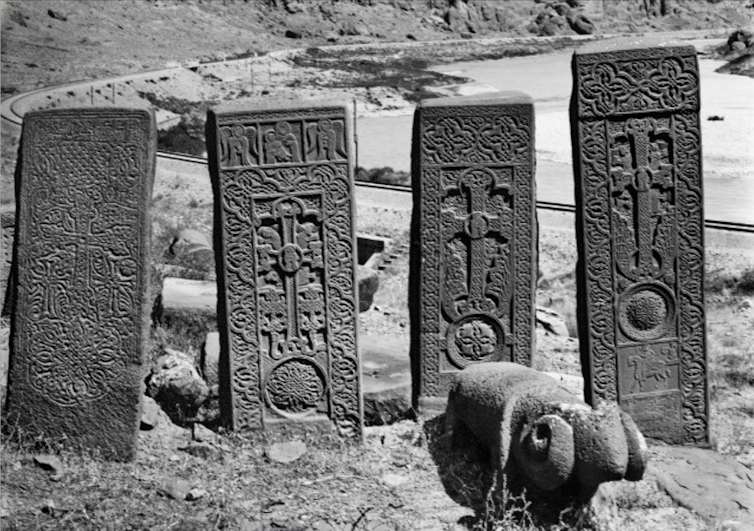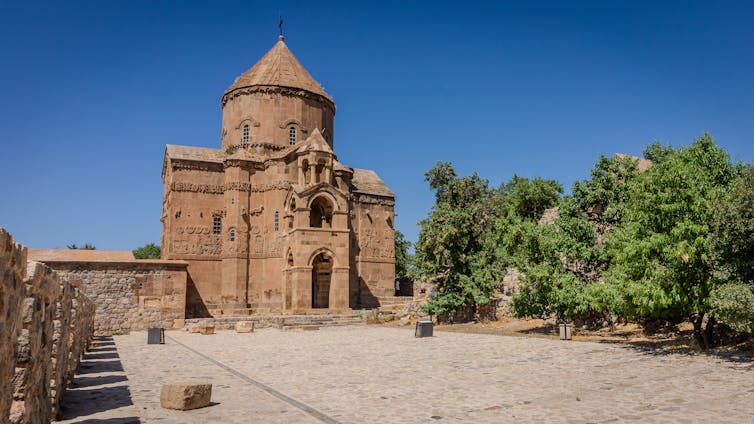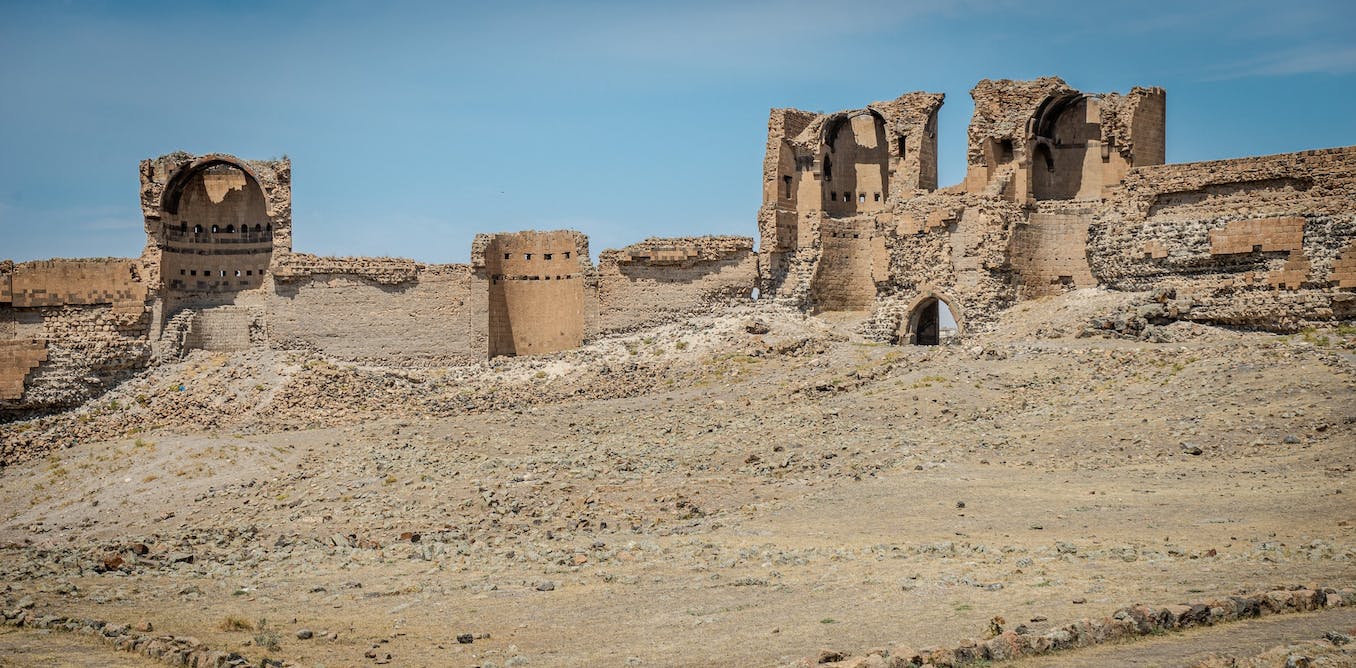On 25 December 2023, the Azerbaijan parliament (the Milli Majlis) passed a declaration claiming that, in what is currently Armenia, there was previously an Azerbaijani community that was displaced by conflict. Though based on scant evidence and flimsy rhetoric, this document also states the right of Azerbaijanis to return to these lands.
Further aggression by Azerbaijan against Armenia can therefore not be ruled out, despite steps towards a possible truce in recent months. Several countries, including France and Iran, have already warned Azerbaijan against an occupying the southern Armenian province of Syunik to gain access to its Nakhchivan exclave via the Zangezur corridor, which runs along the Iran-Armenia border.
In addition to Azerbaijan’s strategic aims, there is a history of ethnic cleansing and genocide in the region. This has entailed massive cultural, as well as human, losses.
A city divided
Iran is the only Muslim-majority country in the region where the Armenian diaspora still coexists relatively peacefully. There, Armenian historical heritage is respected and visited by people of all faiths, and is even promoted to tourists.
In the Northern Iranian city of Jolfa, Armenian culture is treated with pride. The churches and monasteries are cared for, and visited by thousands of travellers a year, most of them Iranians (including those of Armenian heritage). Its architectural jewel is the Saint Stepanous monastery, built in the 9th century and renovated several times. Thanks to the efforts of the Iranian state, it has been declared a UNESCO World Heritage Site.
Alireza Javaheri/Wikimedia Commons, CC BY
However, this is only half the story, as today the city is divided into two halves by the Iran-Azerbaijan border, which runs through it. Until the 19th century the two halves formed a single urban unit, but after Persia’s defeat in the war with Russia between 1826 and 1828, the northern side of the city passed into Russian hands. When the Soviet Union collapsed, it was then integrated into Azerbaijan.
On the Azerbaijani side there are no traces of Armenian culture, following a systematic campaign to remove them in recent decades. This tragic loss is epitomised by Jolfa’s medieval cemetery, where over 3,000 Khachkars (Armenian stone crosses) have been destroyed, an event that British newspaper The Guardian has dubbed “the worst cultural genocide of the 21st century”.

Wikimedia Commons
Erasing Nagorno Karabakh
After Armenia’s defeat in Nagorno Karabakh in September 2023, and the subsequent exit of both international journalists and NGOs – meaning the progressive withdrawal of media attention and humanitarian aid – it is not difficult to imagine that here too, efforts are already underway to wipe any traces of Armenian heritage off the map.
Importantly, Azerbaijan does not allow visits to verify that protections on Armenian cultural heritage sites are being respected. They can therefore only be monitored by satellite, and from such a distance it is all but impossible to document the events on the ground.
In Nagorno Karabakh there are around 500 historical sites, home to approximately 6,000 Armenian monuments that are now under the control of Azerbaijani armed forces. However, their destruction is not just the work of the military. The swift colonisation programme put in place by President Ilham Aliyev includes urban reorganisation and reoccupation of urban and rural areas.
This too has a historical precedent. During the first Nagorno Karabakh war in the 1990s, Azerbaijani authorities decided to eliminate all Armenian presence in the country, be it human or cultural, in what was known as the Baku pogrom.
This caused an exodus among Azerbaijan’s Armenian community, which had previously made up a substantial part of the population of cities like Baku. In the Nakhchivan exclave alone, a total of 5,849 stone crosses, 22,000 tombs and 89 medieval churches were destroyed, according to figures from the academic Nélida Elena Boulgourdjian.

F. Camacho Padilla
The destruction is reminiscent of the fate of the Armenian architectural heritage across Turkey during the 20th century, where very little was done to preserve, recover or restore it. The few exceptions were the Cathedral of the Holy Cross at Lake Van, and the historic city of Ani, capital of the kingdom of Bagratid Armenia. The latter of these was declared a UNESCO World Heritage Site in 2016.
The international community’s muted response
In recent decades, the Armenian diaspora – along with a considerable number of other institutions and organisations including the European Parliament – have spoken out against the crimes committed against Armenia’s cultural heritage.
Until only recently, this had been met with silence from most of the international community, and even UNESCO’s response was lacklustre, as pointed out by the University of Cornell. Caucasus Heritage Watch, which forms part of Cornell, has been closely following Azerbaijan’s destructive trail, regularly publishing monitoring reports that include photos and detailed information of the crimes being committed against Armenian heritage sites. In doing so, it is calling for international mobilisation and condemnation of Baku’s actions, though with little impact to date.
The severity and the turmoil of other global conflicts – some of them relatively close to the Caucasus, such as the war in Ukraine and the Israeli invasion of Gaza – leave little room for reporting on this situation. This leaves the Armenian people, once again, to fend for themselves.
Armenian heritage is, in fact, currently under threat in Israel: over the last three years, an Israeli company has tried to buy up 25% of Jerusalem’s 1500 year old Armenian quarter to build luxury homes. Local Armenian resistance has stalled the project by occupying work sites, but not without violent repercussions. With the world’s eyes on the ongoing atrocities being committed in Palestine this is receiving little attention, despite clear parallels with events in Gaza.
The systematic destruction of cultural heritage – in addition to being a crime against the history of humanity itself – highlights the cruelty and lack of ethics of those responsible. As with the Buddhas of Bāmiyān in Afghanistan, which were dynamited in March 2001 by the Taliban, there is no way to bring back the legacy of an entire people once it has been destroyed.



